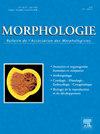后髁管:干颅骨的解剖学研究
Q3 Medicine
引用次数: 0
摘要
人类头骨包含各种孔,包括后髁管(PCC),它允许信使静脉通过。PCC连接颈静脉孔与髁窝,促进颈静脉球与枕下静脉丛之间的静脉引流。由于其不同的大小和位置,PCC可能被误认为是病理结构,给神经外科手术带来挑战。虽然经髁入路在颅椎手术中越来越受欢迎,但关于PCC变化的研究有限。本研究的目的是估计干成人颅骨PCC的患病率,并研究其形态学,因为它的临床重要性。材料与方法对52个保存完好的干燥成人颅骨进行了横断面观察研究。排除有病理改变或畸形的颅骨。使用Kerr根管锉评估PCC的存在、开放程度和长度,以及孔的内外直径,并使用数字游标卡尺测量。采用常规统计学方法对数据进行评价。结果52例颅骨中,98.1% (n = 51)可见PCCs,其中双侧84.6% (n = 44)可见PCCs,单侧13.5% (n = 7)可见PCCs。PCC平均长度为右侧11.8±2.9 mm,左侧11.5±2.8 mm,两侧差异无统计学意义(P = 0.96)。外径平均为3.9±1.7 mm(右)和3.4±1.2 mm(左),内径平均为5.0±1.7 mm(右)和4.8±1.5 mm(左),差异无统计学意义(P >;0.24)。大多数PCC开口为中型(2-5毫米),而大型(>;5毫米)和小(<;2mm)孔较少见。结论PCC非常普遍,主要是双侧,大多数开口为中等大小。这些发现强调了PCC的解剖学意义及其在涉及枕髁和颈静脉孔的放射学和外科手术中的相关性。本文章由计算机程序翻译,如有差异,请以英文原文为准。
The posterior condylar canal: An anatomical study on dry human skulls
Background
The human skull contains various foramina, including the posterior condylar canal (PCC), which allows the passage of emissary veins. The PCC connects the jugular foramen to the condylar fossa and facilitates venous drainage between the jugular bulb and suboccipital venous plexus. Due to its variable size and location, the PCC can be mistaken for pathological structures, posing challenges during neurosurgical procedures. While the transcondylar approach has gained popularity in craniovertebral surgeries, limited research exists on PCC variations. The aim of this study was to estimate the prevalence of PCC in the dry adult human skulls and to study their morphology due to its clinical importance.
Material and methods
A cross-sectional observational study was conducted on 52 well-preserved dry adult human skulls. Skulls with pathological changes or deformities were excluded. The presence, openness, and length of the PCC, as well as the external and internal diameters of the foramina, were assessed using Kerr endodontic files and measured with digital Vernier caliper. Conventional statistical methods were used to evaluate the data.
Results
Among 52 skulls, 98.1% (n = 51) had visible PCCs, with 84.6% (n = 44) showing bilateral and 13.5% (n = 7) unilateral presence. The mean PCC length was 11.8 ± 2.9 mm on the right and 11.5 ± 2.8 mm on the left, with no significant difference between sides (P = 0.96). External diameters averaged 3.9 ± 1.7 mm (right) and 3.4 ± 1.2 mm (left), and internal diameters were 5.0 ± 1.7 mm (right) and 4.8 ± 1.5 mm (left), with no statistical difference (P > 0.24). Most PCC openings were medium-sized (2–5 mm) while large (> 5 mm) and small (< 2 mm) orifices were less common.
Conclusions
The PCC was found to be highly prevalent, predominantly bilaterally, with most openings exhibiting medium sizes. These findings highlight the PCC's anatomical significance and its relevance in radiology and surgical procedures involving the occipital condyle and jugular foramen.
求助全文
通过发布文献求助,成功后即可免费获取论文全文。
去求助
来源期刊

Morphologie
Medicine-Anatomy
CiteScore
2.30
自引率
0.00%
发文量
150
审稿时长
25 days
期刊介绍:
Morphologie est une revue universitaire avec une ouverture médicale qui sa adresse aux enseignants, aux étudiants, aux chercheurs et aux cliniciens en anatomie et en morphologie. Vous y trouverez les développements les plus actuels de votre spécialité, en France comme a international. Le objectif de Morphologie est d?offrir des lectures privilégiées sous forme de revues générales, d?articles originaux, de mises au point didactiques et de revues de la littérature, qui permettront notamment aux enseignants de optimiser leurs cours et aux spécialistes d?enrichir leurs connaissances.
 求助内容:
求助内容: 应助结果提醒方式:
应助结果提醒方式:


